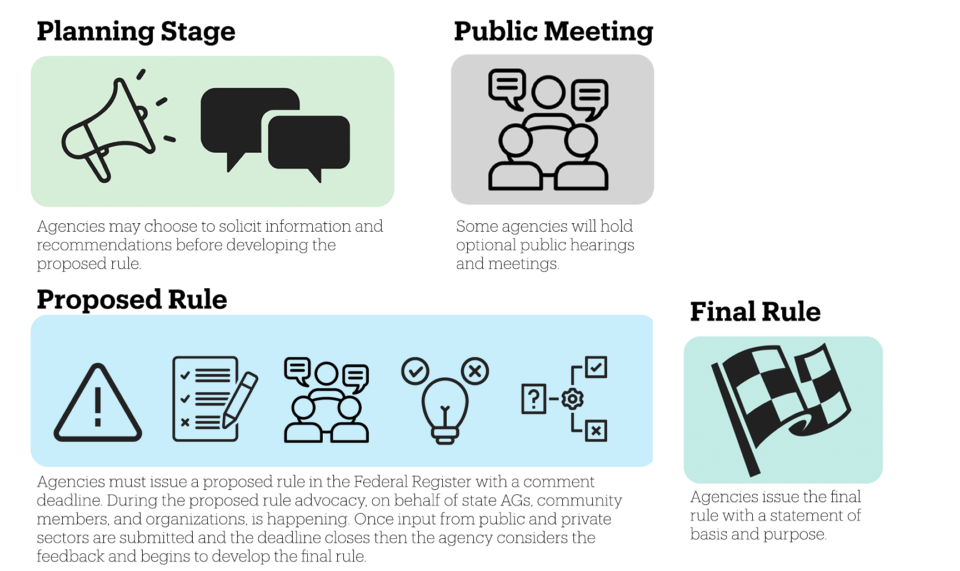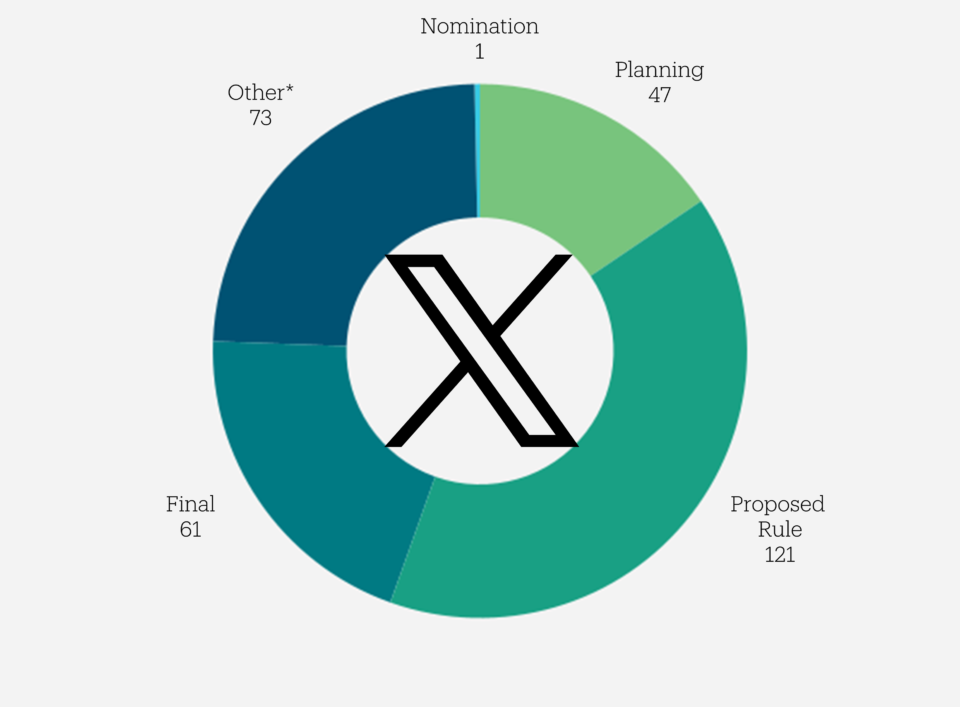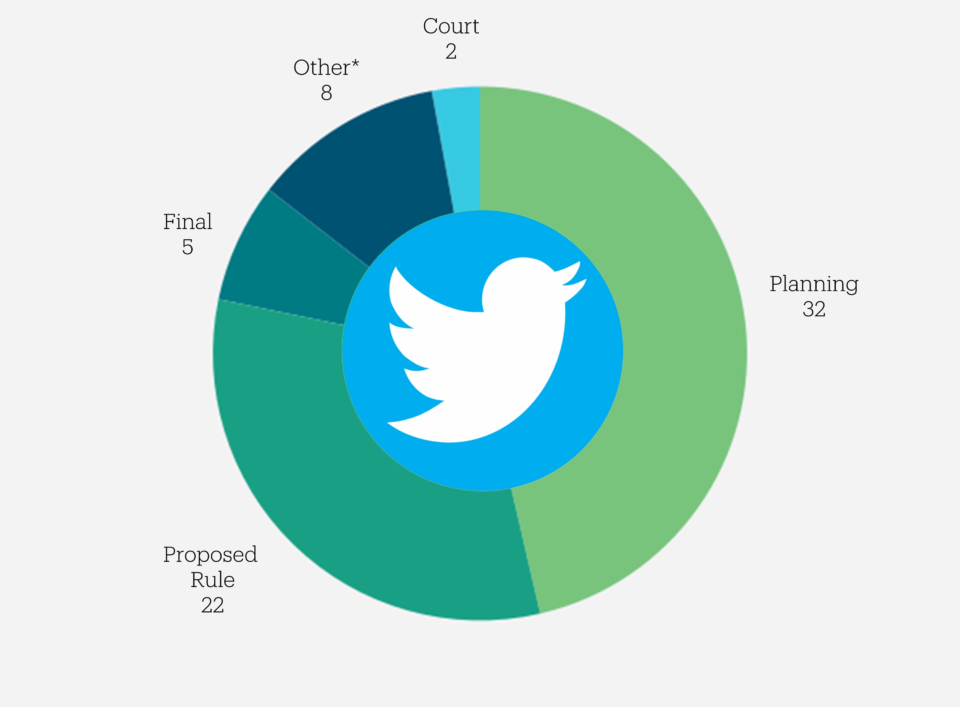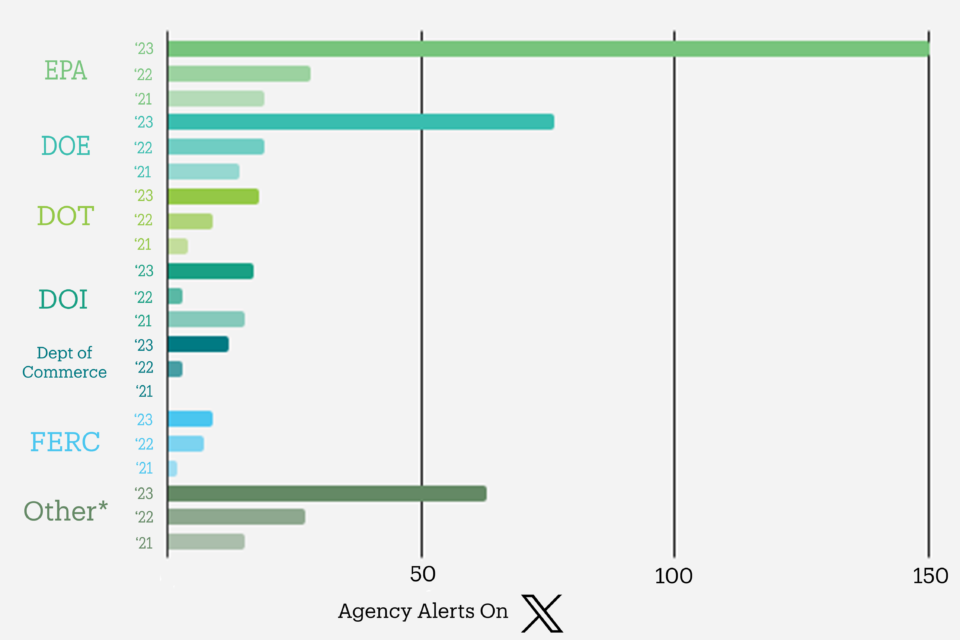Rounding Up the 2023 Regulatory Process with #StateImpactAlert
Carlos E. Minaya Arnao (Communications Manager) / December 15, 2023
This past year has seen federal agencies take significant actions on climate and clean energy, while state attorneys general (AGs) continue to push the Biden administration to finalize stronger rules.
One theme in the agency world has been an effort to broaden public participation in the regulatory process. The Office of Information and Regulatory Affairs released guidance in July encouraging federal agencies “to inform their regulatory actions through meaningful and equitable opportunities for public input by a range of interested or affected parties, including underserved communities.”
This past year, our tracking has shown that this administration has taken action in 303 matters across 29 agencies, up from 100 actions (across 21 agencies) in 2022, and 69 actions (across 15 agencies) in 2021.
The State Impact Center uses the #StateImpactAlert hashtag on X (formerly Twitter) to track these actions. We collect and provide this data to support public engagement with actions that may affect peoples’ day-to-day lives.
The alerts in 2023 covered: proposals, final rules, extensions of comment periods, requests for comment on policy statements and other draft reports, notifications about final determinations, notifications of meetings and workshops, and requests for information on research and data.
Figure 1 below shows the standard rulemaking process agencies follow when developing regulations for their sector.
Fig. 1 Rulemaking Flowchart

State Impact Center. (2022). Where Are We Now?. Page 23.
As of December 15, 2023, we had tracked 47 actions in the planning stage, 121 in the proposed rule stage, and 61 in the final stage in 2023. The figures below show this breakdown, with Figures 3 and 4 displaying the data for 2022 and 2021, respectively.
A more detailed summary of 2022 alerts is found in our “Where Are We Now?” policy report, and alerts from 2021 can be found in our “#StateImpactAlert Makes Participating in Rulemaking Easy” blog post.
Fig. 2 Alert Breakdown for 2023

*The “Other” category refers to actions such as requests for information, notices of availability, workshops, public meetings, and notices of final determinations.
State Impact Center (2023), #StateImpactAlert 2023 Alerts & Data.
Fig. 3 Alert Breakdown for 2022

*The “Other” category refers to actions such as requests for information, notices of proposed rulemaking, notices of availability, workshops, and notices of public meetings.
State Impact Center. (2022). Where Are We Now?. Page 17.
Fig. 4 Alert Breakdown for 2021

State Impact Center. (2021). #StateImpactAlert Makes Participating in Rulemaking Easy.
We saw agency actions increase this year. The Biden administration has continued its efforts to reverse the previous administration’s environmental rollbacks, efforts that Grist tracked throughout 2022, by giving direction to federal agencies. Direction urging agencies to make it easier for the public to meaningfully participate in the rulemaking process, as noted above. And direction to consider the social cost of greenhouse gasses in their budget development, procurement, and review process. Additional Executive Orders, like this one from April on “Revitalizing Our Nation’s Commitment to Environmental Justice for All”, have also made clear the priorities of the administration for its agencies. The effects of these actions from the Biden administration are seen in the actions agencies have taken this year.
For example, agencies, such as Health and Human Services (HHS) and Department of Homeland Security, have posted fact sheets and updated their websites to show how they are paying attention to the effects of the climate crisis on the sectors they regulate. They have also engaged in the regulatory process in the areas that we track to ensure safeguards are in place. HHS began collecting comments in November on proposed revisions to its floodplain management procedure to better include climate science. Another agency that has taken similar steps is the Internal Revenue Service (IRS). The IRS began collecting comments in June 2023 on a program designed to incentivize solar and wind powered generation facilities in environmental justice communities. The IRS finalized this program in October, a direct result of the Inflation Reduction Act (IRA). We covered the clean energy funding that was being distributed by the IRA in an October 2022 blog post, “Carving Out Funds for Clean Energy.” The Federal Reserve System and Federal Deposit Insurance Corporation, which issued principles for the safe and sound management of exposures to climate-related financial risk for institutions with over $100B in total consolidated assets. The Geological Survey sought comments on its information collection process regarding social vulnerability and inequities associated with coastal storm flooding in urban neighborhoods.
Figure 5 below shows the breakdown of our posts by agencies for 2023, 2022, and 2021.
Fig. 5 Alert Breakdown by Agency by Year

*The “Other” category refers to the following agencies: ACHP, CPSC, Dept. of State, DHS, DOD, DOJ, DOL, EOP, FDIC, FPISC, Federal Reserve System, GSA, HHS, HUD, NASA, NCUA, NRC, OSTP, SBA, SEC, Treasury, USDA, USTDA, USGS.
2023 Data - #StateImpactAlert 2023 Alerts & Data.
2022 Data - Where Are We Now?. Page 16.
2021 Data - #StateImpactAlert Makes Participating in Rulemaking Easy.
These alerts have engaged many members of the public. The Center’s #StateImpactAlert hashtag, through the end of November 2023, had a 4.4% engagement rate. Here are a few examples of posts with high engagement rates, compared to the average X engagement rate for government profiles of 1.36% and a nonprofit engagement rate that averaged at 1.33%, according to social media industry professionals, like Hootsuite. On June 26, we flagged a proposed rule by the Pipeline and Hazardous Materials Safety Administration (PHMSA) to compile and provide safety information to first responders. That tweet had an engagement rate of 10%. On July 27, we flagged a proposed rule by DOE that would affect consumer water heaters. The engagement rate there was 17%.
As the top state lawyer and the people’s lawyer, an AG can look at an action proposed by a federal agency and work to support it, push back on it, or offer alternative strategies to what was proposed. For example, a coalition of 13 AGs submitted comments to PHMSA in response to the agency’s proposed rule about information that first responders need when dealing with a train accident. In response to a notice from the EPA requesting comments on their Draft National Strategy to Prevent Plastic Pollution, a coalition of 14 AGs submitted a comment letter providing evidence from communities on the health impacts of living near plastic production facilities and calling on EPA to work with states on further strategies. In both of these cases we covered the federal agency action and reported on the response by the AGs. We provide a variety of resources for people interested in learning about the relationship between the state and federal government on issues that affect everyone.
To read more about AG Actions, see the State Impact Center’s database tracking actions and comments, and bi-weekly newsletter Legally Speaking.
In 2024, follow the #StateImpactAlert to see how agencies do in finalizing all of the pending rules and more information about AG engagement across these actions.
